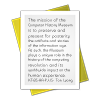Title
Bingham, John interviewCatalog Number
102738563Type
DocumentDescription
John Bingham received his BSc from Imperial College, London in 1956 and his MSEE from Stanford University in 1961. He first began working on modems during his last few years with GTE Lenkurt (1959-1969). Next he worked on modems at Fairchild (1969-1970), before switching to Memorex (1970-1972) to do the same. When he presented some novel ideas on multiplexing to management, he realized that the same thing had happened to him as it had at Fairchild, management had lost their commitment to develop their own modems. Feeling as though he had come up with something important, he contacted Dennis Anderson, an engineer he had worked with at Fairchild who he knew was now Chief Engineer at Vadic. He was invited to present his ideas to Anderson, Kim Maxwell and Ted Saunders. Maxwell questioned if his filtering ideas would work with more channels? Bingham left with an invitation to return. After a few weeks Bingham returned to explain to the Vadic engineers how it would work. They weren’t sure, but hired him to work in June 1972 to design a new 1200 bps full duplex modem.The team released the V3400 in May 1975. But it would not be until 1976 when the V3400, the first robust 1200 bps full duplex modem on the market, was perfected. It was a good time for Vadic until AT&T introduced their competitive Bell 212 in September 1976. The bad news: the Bell 212 also supported the Bell 103, which the V3400 didn’t. The Vadic engineers scrambled as UDS and others introduced their products. It was almost 1979 before a product conceived by Maxwell and engineered by Bingham, a modem that responded as if it were a Bell 103, a Bell 212 or a V 3400 depending on the calling modem was perfected. The V 3467 became known as the “triple modem” and because of it the sales of Vadic skyrocketed. All to the advantage of Racal Electronics who had recently bought Vadic as a means to resolve shareholder discontent.
Bingham would work on other projects in the years ahead but none as impactful as the V 3467. By 1985, when Bingham resigned, Vadic had grown to nearly$100M company and had become the largest dial-up modem company behind AT&T, all based on technologies that no one thought possible and through unfortunate error, Vadic lost its patents; patents that would be nearly as valuable as the profits on its product sales. Bingham retired with the title of manager of the Advanced Development Department of Racal-Vadic Corporation a subsidiary of Racal Electronics PLC.
Date
1988-03-23Contributor
| Bingham, John, Interviewee |
| Pelkey, James L., Interviewer |
Publisher
Computer History MuseumPlace of Publication
Palo Alto, CAFormat
PDFCategory
TranscriptionCollection Title
James L. Pelkey collection : history of computer communicationsCredit
Gift of James PelkeyLot Number
X5671.2010Related Records
| 102746648 | James L. Pelkey collection : history of computer communications |


